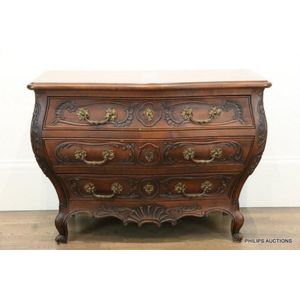Cherry Wood Bombe Commode with Gilt Brass Handles
A Louis XV style bombe style cherry wood Bordelaise commode, circa 1930, the commode with three bow fronted serpentine drawers, with gilt brass handles and escutcheons, decorative mouldings, on short, scrolled Feet, height 86 cm, width 118 cm, depth 61 cm
You must be a subscriber, and be logged in to view price and dealer details.
Subscribe Now to view actual auction price for this item
When you subscribe, you have the option of setting the currency in which to display prices to $Au, $US, $NZ or Stg.
This item has been sold, and the description, image and price are for reference purposes only.
- Circa - A Latin term meaning 'about', often used in the antique trade to give an approximate date for the piece, usually considered to be five years on either side of the circa year. Thus, circa 1900 means the piece was made about 1900, probably between 1895 and 1905. The expression is sometimes abbreviated to c.1900.
- Mouldings - Decorative strips, deriving from architectural features, that may be either applied separately to a piece of furniture or worked directly on to the carcase. Mouldings are found on cornices or pediments, around the edges of panels and drawer fronts, and around both the tops and bottoms of chests, bookcases and other cabinet furniture. Until the late 19th century mouldings were worked by hand, using a shaped moulding plane. Latterly, they have been shaped by machine.
- Bow Front - The front is shaped in a gentle curve or bow. Introduced during the 18th century, the bow-front is associated with furniture of the Hepplewhite and Sheraton period, though of course the form continued to be used throughout the 19th century. Bow-fronted pieces are usually veneered, although some were cut from the solid wood. Where veneer is used, the carcase is cut either from pine or deal, or sometimes the front was built up and shaped with small timber 'bricks'. Commonly used on various types of furniture including chairs, settees, chests, side tables, sideboards and display cabinets.
- Commode - The word "commode" when used to describe an item of furniture, has three usuages:
1. As used to describe an item of English furniture, it refers to what is euphemistically called a 'night table', that is a small cabinet concealing a chamber pot.
2. In its 18th century French usuage it describes a low and highly decorated chest of drawers for salons and reception rooms. A bombe commode is a commode with rounded sides and front, giving the chest a somewhat swollen look.
3. It is also used to denote a half round or serpentine shaped cabinet, with panelled doors, standing on legs. They were pieces on which the cabinetmaker lavished his most accomplished art, with rich veneers, marquetry inlays, gilt mounts and other ornamentation. - Escutcheons - An escutcheon is a plate, made of brass, wood, ivory or ebony, which fits into or over the h keyhole, to protect the edge of the timber keyhole from damage by continual insertions of the key. As a general rule you would expect these escutcheons to be sympathetic in design to the handles of the piece. From the early 19th century escutcheons were sometimes made from ivory, ebony, bone or contrasting wood, often cut in a diamond or shield shape and inlaid into the front. Ivory, in particular, will tend to discolour with age, and certainly should not show up as brilliantly white.
- Bombe Front - More commonly associated with a dome shaped dessert, "bombe" in furniture parlance means "puffed out". In profile the piece is serpentine shaped, narrow at the top, swelling out towards the middle and continuing to the floor, though sometimes it narrowed again at the foot. Drawer fronts are curved in section. Bombe pieces are often highly decorated with marquetry inlay, or veneered and set with brass or ormolu mounts. The most common use of the word, is in the description of the 'bombe commode'.
The bombe design was particularly popular in the 18th century, during the reign of Louis XIV, when it was used to create furniture pieces with a curved, rounded bulging shape. This design was used on furniture in many styles, including Baroque, Louis XIV, Louis XV and Louis XVI. The bombe chest is one of the most iconic furniture piece featuring this design. They were usually made of precious woods like mahogany, rosewood, and walnut, and feature elaborate inlay, gilded ornaments and ormolu. Other items of furniture where the bombe design can be seen include cabinets, commodes, and desks. - Serpentine - Resembling a serpent, in the form of an elongated 'S'. A serpentine front is similar to a bow front, except that the curve is shallow at each end, swelling towards the middle. The term presumably derives from its similarity to a moving snake or serpent. Serpentine fronts are usually veneered, with the carcase either being cut and shaped from a solid piece of timber, or built in the 'brick' method.
This item has been included into following indexes:
